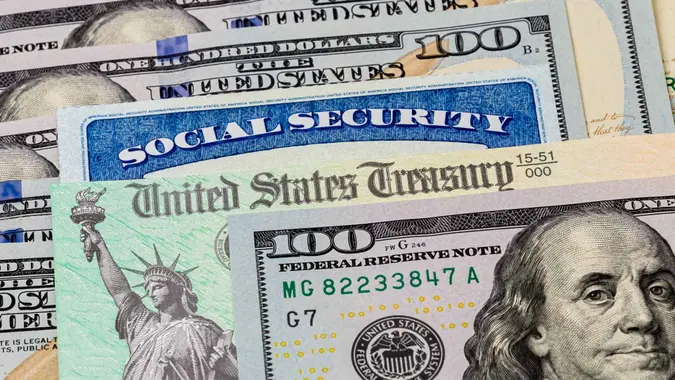6 Smart Ways To Use Your Social Security Income After Retiring

Commitment to Our Readers
GOBankingRates' editorial team is committed to bringing you unbiased reviews and information. We use data-driven methodologies to evaluate financial products and services - our reviews and ratings are not influenced by advertisers. You can read more about our editorial guidelines and our products and services review methodology.

20 Years
Helping You Live Richer

Reviewed
by Experts

Trusted by
Millions of Readers
Deciding how to use Social Security checks can be daunting. The program replaces only about 40% of pre-retirement income on average, so every dollar matters.
GOBankingRates asked experienced financial planners for practical strategies to simplify choices. Their advice covers budgeting essentials, coordinating with other income and avoiding tax surprises so you can feel secure about the years ahead.
Cover Essential Expenses First
“Think of Social Security as the foundation of your retirement income, not the whole structure,” said Adam Spiegelman, founder and wealth advisor at Spiegelman Wealth Management in Alamo, California. He advised using those monthly checks to pay for non-negotiable costs, like housing, groceries and healthcare, so you’re not forced to pull from investments to meet day-to-day needs.
Jordan McCallum, regional sales director at Southern Ohio Retirement Group, agreed. He said essentials, such as utilities, food and Medicare premiums (often deducted directly from your benefit) should be covered by Social Security. Travel, hobbies and other discretionary spending should come from savings or investment accounts. “Your Social Security check is a reliable income for life. It should be prioritized for essential expenses,” McCallum said.
Covering these essentials first ensures your Social Security income provides steady support before you draw on other savings.
Coordinate With Other Income Sources
Social Security is only one leg of a solid retirement plan. Pensions, 401(k)s, IRAs and brokerage accounts are others. Spiegelman recommended coordinating withdrawals and investments to smooth cash flow and reduce taxes.
Lisa A. Cummings, an attorney at Cummings & Cummings Law, suggested meeting with a CPA to map out projected income and required minimum distributions. By understanding how each piece fits together, you can avoid tapping investments prematurely and manage your tax bracket over time.
Build a Cash Cushion for Emergencies
Even with steady checks, unexpected expenses, like a sudden roof repair, a medical bill or a broken appliance, are likely to arise.
Cummings suggested keeping six to 12 months’ worth of essential expenses in a money market account or other highly liquid savings. That buffer allows you to handle surprises without selling investments during a market downturn.
Think in Buckets for Stability and Growth
One way to keep your money working for both today and tomorrow is to divide it by time horizon. To create long-term balance, McCallum recommended a “bucket strategy.”
- Bucket one: Checking or savings accounts for immediate needs over the next two years. This is where Social Security and pension income land.
- Bucket two: A safety net for the next five to 10 years, often with fixed annuities or other low-volatility investments.
- Bucket three: Long-term growth invested in stocks or mutual funds to help beat inflation.
This system makes it easier to see which dollars are for daily living and which can stay invested for the future.
Plan for Taxes and Hidden Medicare Costs
Don’t assume Social Security is tax-free. “Up to 85% of Social Security benefits can be taxable,” Spiegelman warned. Coordinating withdrawals from other accounts, using Roth accounts or making charitable gifts directly from IRAs can help lower that bill.
Christine Lam, CFP, investment advisor representative with Financial Investment Team in Portland, mentioned another layer to watch out for: Medicare’s income-related monthly adjustment amount (IRMAA) surcharge.
“It is a monthly tiered surcharge tacked on to Medicare Parts B and D premiums. But it only happens if you have income over $106,000 for single filers and $212,000 for married couples filing a joint return,” she explained. Lam often recommends Roth conversions before required distributions kick in, as well as qualified charitable distributions, to help manage taxable income and avoid those surprise surcharges.
Review and Adjust Every Year
A retirement plan isn’t static, and you should be sure to review your strategies for utilizing your Social Security and other retirement income.
Cummings advised updating your cash flow analysis annually to reflect cost-of-living adjustments, inflation and rising healthcare costs. Small tweaks, like rebalancing investments or adjusting withdrawal rates, can help keep your plan on track.
More From GOBankingRates
 Written by
Written by  Edited by
Edited by 

























